Can I deploy virtual infrastructure on HP in 15 minutes?
Yes, if it’s the HP ConvergedSystem 200.
This year we wrote about the announcement of the HP CS200 for virtualization environments, now it's time to see how these systems work in business. Our colleagues from Belgium organized a demo stand of 3 systems to demonstrate all the capabilities of the HP hyper-converged platform, and we publish a report on their work.
The organization of the stand was aimed at the practice of showing all the benefits declared on the HP website.

. The main one is deployment speed, namely, the transition to the deployment of virtual machines in the vCenter interface within 15 minutes after turning on the power. Here are all the steps that will be required to build such an infrastructure. Looking ahead, I’ll say that for a start it will be necessary to determine 23 unoccupied IP addresses, so we check the list of available IP addresses and go!
First note: the boxes are quite heavy - heavier than the HP ProLiant DL380. This is because each HP CS200 comes with 4 independent servers, each with its own processors and memory. The platform is also available separately under the name HP ProLiant SL2500.
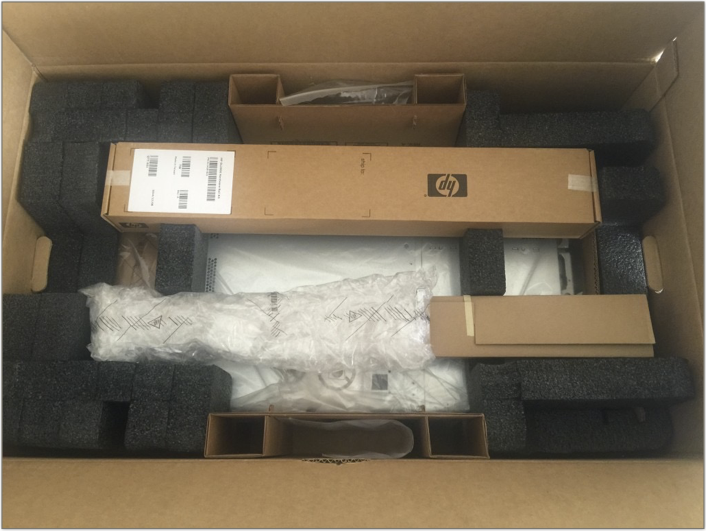
Immediately behind the rack rails, we find an envelope with useful installation information and Read First documentation.
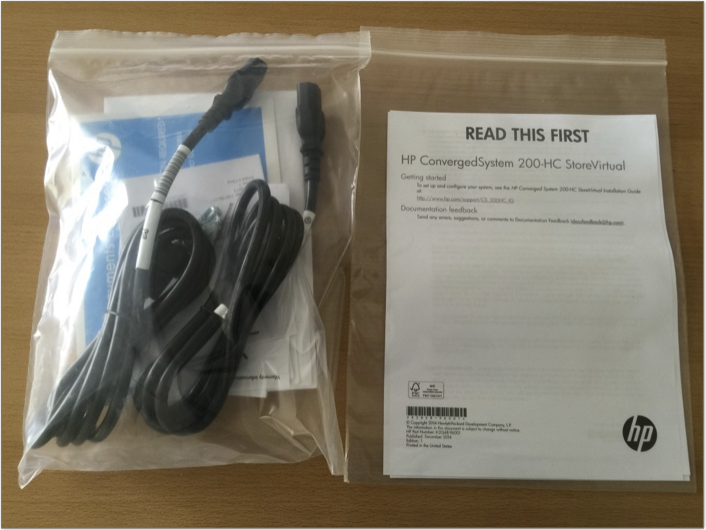
The latest installation instructions can be found on the HP website. A complete user guide is also available .
The front panel has 24 compartments for installing small form factor disks (depending on the CS 200 model, it can be either fully 10K SAS disks or a hybrid version of SAS and SSD). Disks are physically divided between 4 server nodes in the chassis (6 disks per each node's RAID controller).
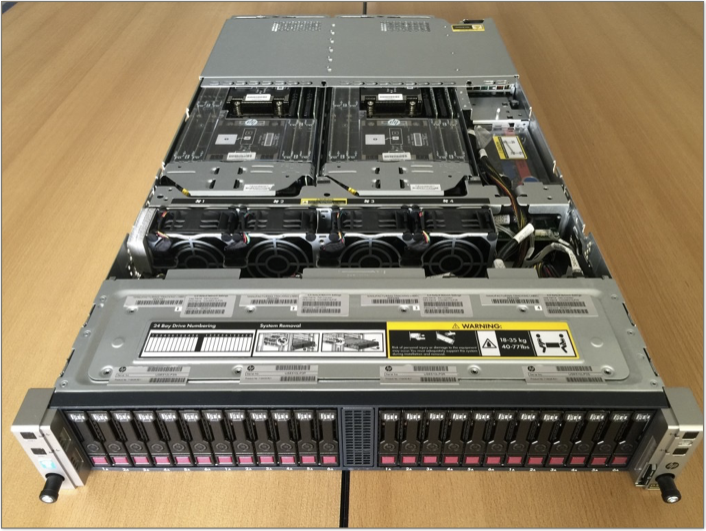
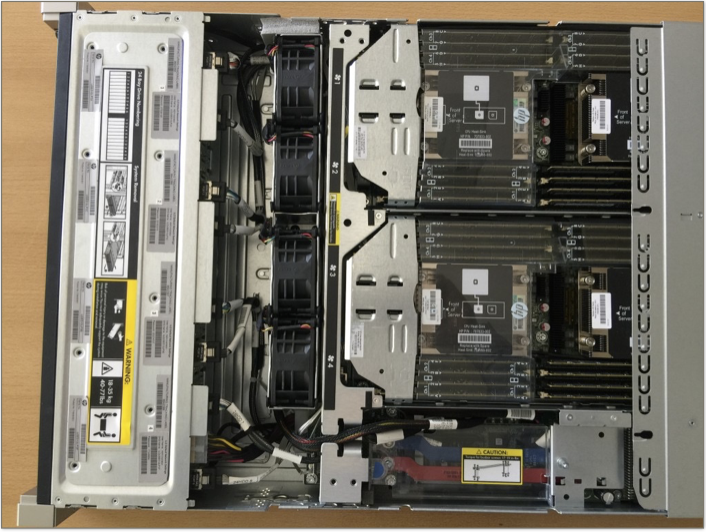
The rear panel of the chassis allows you to see 4 independent server nodes with separate ports for connecting to the network.

Each node has 2 10Gb ports for connecting to the network, also on each node there are 2 separate 1Gb ports that are not used in operation and are closed with plastic plugs. Because Since it is a full-fledged ProLiant server, each node has a separate iLO management port.
The Belgian colleagues and our engineers were impressed by the design of each of the nodes: competently arranged and thought out. Here is a picture of a free-standing CS200 node with 16 memory slots of 16GB, 1TB of memory per chassis. Not bad!
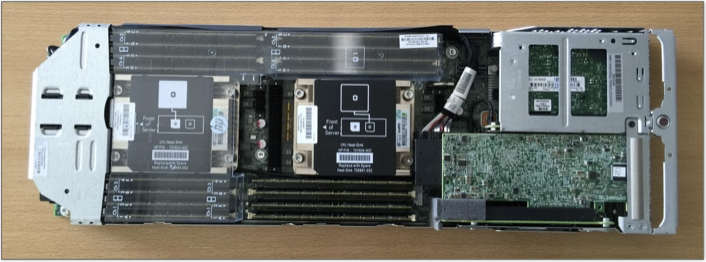
Finally, on the top cover of the chassis, you can find all the necessary information for the first start-up, such as the initial iLO password of each server, and system ID. We also notice the Windows license for the managing VM (below will be a description).
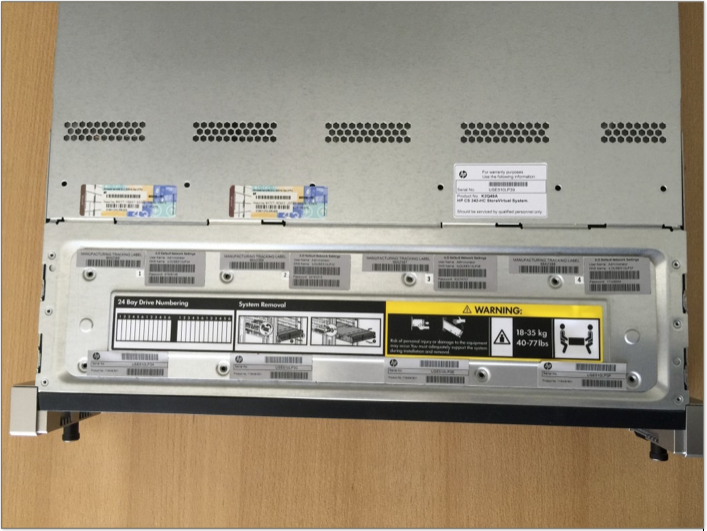
By the way, the ProLiant SL2500 platform can be tested at the HP office in Moscow on Voikovskaya or agreed to test on your site.
After connecting 2 power cables and 8 network cables (8x 10Gb), we begin the installation of the system.

On node 1 (from the bottom right of the chassis), we need to connect one of the 1Gb ports shown in the picture to the laptop for initial launch. These ports will no longer be used.
The system comes pre-installed with ESXi and one Windows-based management VM, which will also host vCenter. For the initial launch, we connect the laptop to the first node and run the OneView Instant-On rapid deployment software. To do this, set the laptop an IP address in the range 192.168.42.x (not 100), then connect via RDP to the control VM at the address 192.168.42.100. We find the login / password on the sticker on top of the chassis, by default it is “administrator” and “hpcs200HC!”.
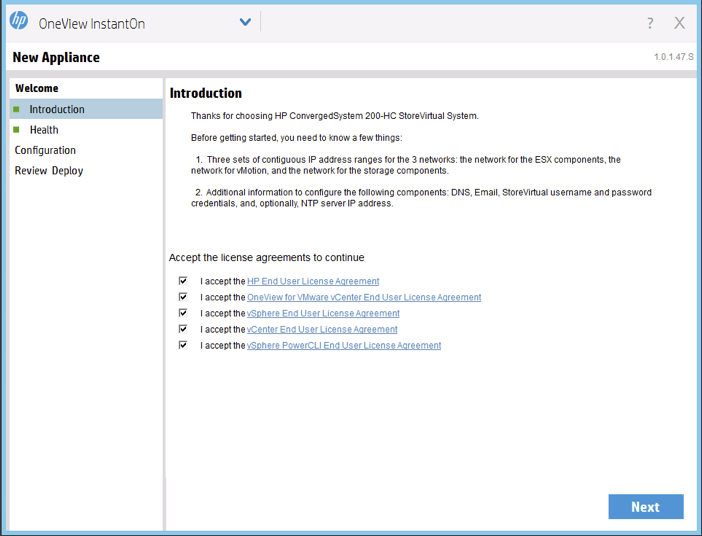
We assume that the user has already familiarized himself with all EULA's from HP and VMware, otherwise it will be difficult to meet the stated 15 minutes!
Click Next.
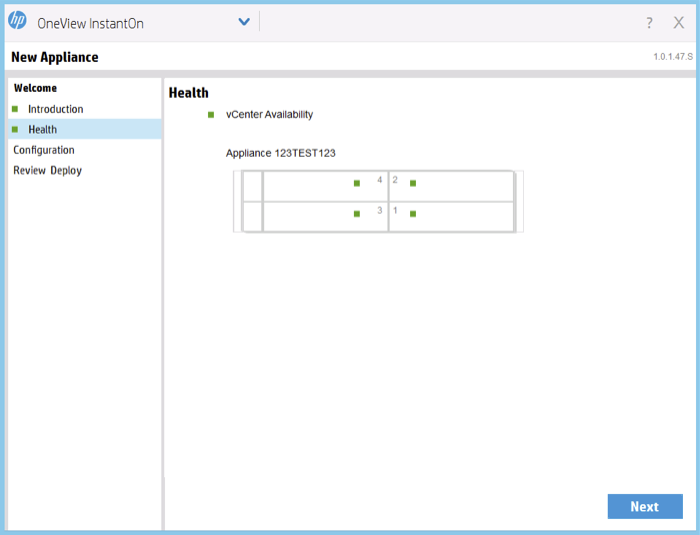
On top of the usual ESXs 5.5 image, a special Discovery Agent is installed in the CS200, which will be used for the initial configuration. Green dots indicate that the installation is proceeding normally and OneView Instant-On can easily communicate with these Discovery agents. You can also see that the system recognized and detected vCenter, we can move on!

This is where our 23 IP addresses come in handy:
- 5 for ESXi hosts and the vCenter management server;
- 4 for vMotion kernel's;
- 14 for iSCSI SAN;
So far, everything is simple, then.
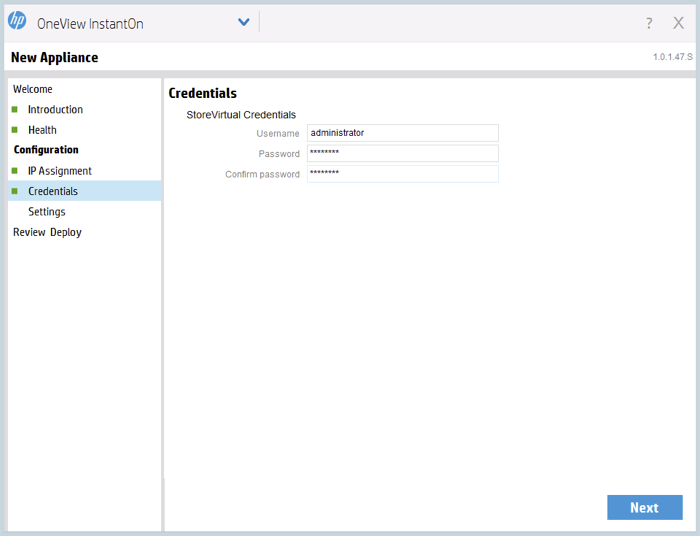
A typical question that arises when installing StoreVirtual iSCSI SAN for a management team is setting permissions.

Some additional settings: DNS, NTP, mail alerts.

Preview of the entered information (all indicators are green, which means that everything is entered correctly) and click "Deploy". Now the system applies all the settings to 4 ESXi nodes and the VSA SAN is configured.
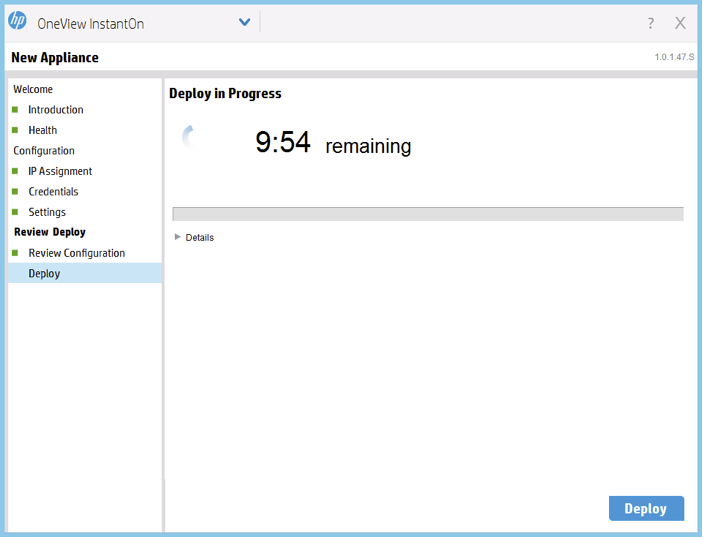
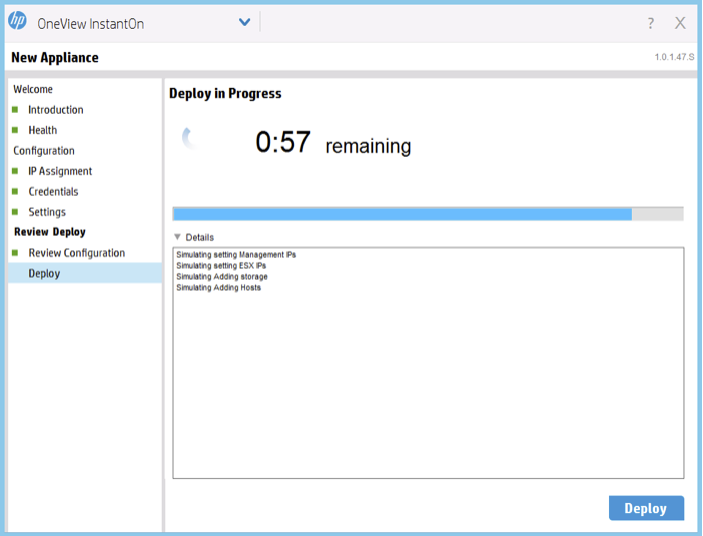
All detailed information is displayed in the installation window.
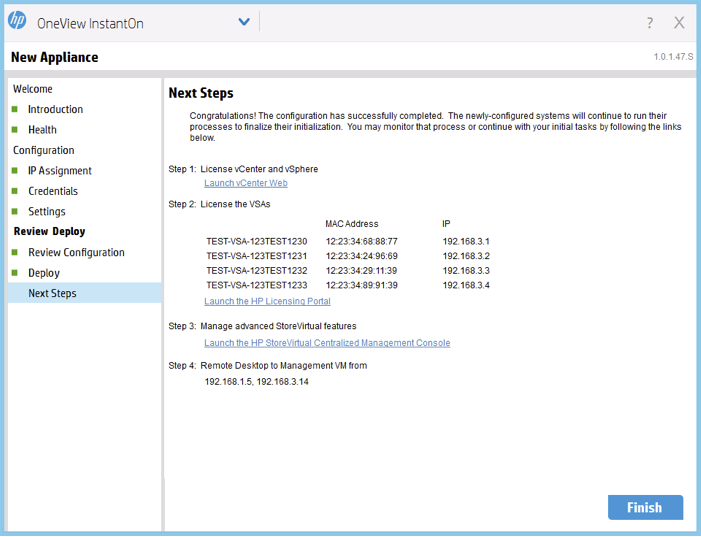
And finally, the system is fully deployed. Then through the web or windows client, or you can connect to vCenter and start the deployment of virtual machines.
The final step is to register your VSA licenses on the HP Licensing Portal. Filed in 15 minutes, as promised.
Fast deployment speed for such a system is not enough, it is necessary that the system also worked quickly. For testing, Iomark-VM benchmark was chosen, which allows determining the system performance as close as possible to real conditions in a virtualization environment. The test was conducted on the HP ConvergedSystem 242-HC StoreVirtual in a configuration that supports up to 144 virtual machines on a chassis. Download the test .
Description of the workload embedded in the test:
- the load should be generated entirely on the system under test;
- the load is divided into a set of 8 threads;
- 70% IO should not exceed a response time of 20ms;
- The average response time of each application should not exceed 30ms;
Hypervisor operations verified in the test:
- cloning, deployment, loading, updating SW, removing VM;
- Data migration (storage migration).
CS200 configuration table:

HP CS200 specifications, number of virtual machines tested, response time and usable capacity tested in the test: The

price shown here is the Global List Price before discounts. For prices, contact your Hewlett-Packard partner.
Hypervisor Test Table: The

configuration of the disk subsystem is available from the test link.
HP ConvergedSystem 242-HC StoreVirtual logical configuration: Rack
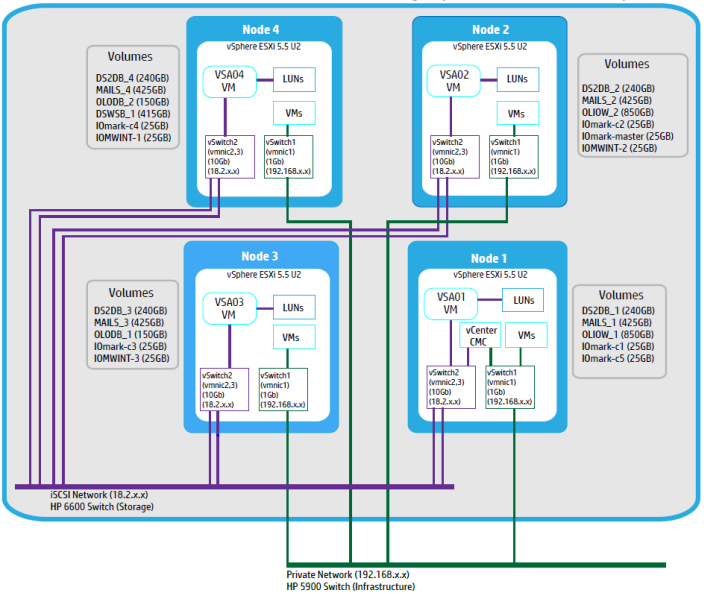
layout:
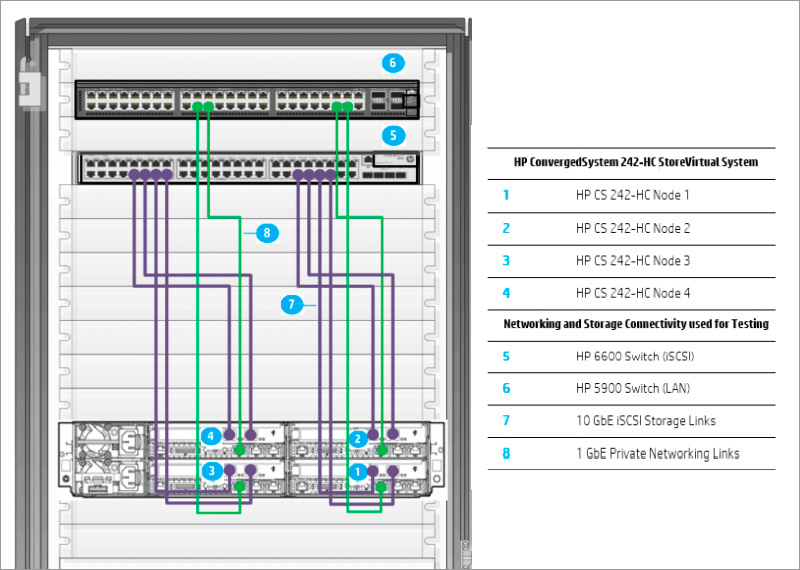
HP ConvergedSystem 242-HC StoreVirtual performance graph obtained from testing:

The result was a very compact and very productive system for virtualization, which our European customers liked very much both in terms of convenience of work, and in cost and performance. I hope you enjoy it too. Stay tuned for further announcements!
Our previous publications:
» HP StormRunner Load. A practical guide. Part II
» HP StormRunner Load. A practical guide. Part I
»The right bonus for your new server
» Cost-effective HP servers for SMB and providers
» HP OpenStack Helion - the first acquaintance
» SDN: an alternative or addition to traditional networks?
"New network architectures: open or closed solutions?
» Implementation of MSA in a virtualized enterprise environment
» HP MSA disk arrays as the basis for data consolidation
» Multi-vendor corporate network: myths and reality
» Available HP ProLiant server models (10 and 100 series)
» Convergence based on HP Networking. Part 1
» HP ProLiant ML350 Gen9 - server with incredible extensibility
Thank you for your attention!

. The main one is deployment speed, namely, the transition to the deployment of virtual machines in the vCenter interface within 15 minutes after turning on the power. Here are all the steps that will be required to build such an infrastructure. Looking ahead, I’ll say that for a start it will be necessary to determine 23 unoccupied IP addresses, so we check the list of available IP addresses and go!
Unpacking
First note: the boxes are quite heavy - heavier than the HP ProLiant DL380. This is because each HP CS200 comes with 4 independent servers, each with its own processors and memory. The platform is also available separately under the name HP ProLiant SL2500.

Immediately behind the rack rails, we find an envelope with useful installation information and Read First documentation.

The latest installation instructions can be found on the HP website. A complete user guide is also available .
The front panel has 24 compartments for installing small form factor disks (depending on the CS 200 model, it can be either fully 10K SAS disks or a hybrid version of SAS and SSD). Disks are physically divided between 4 server nodes in the chassis (6 disks per each node's RAID controller).


The rear panel of the chassis allows you to see 4 independent server nodes with separate ports for connecting to the network.

Each node has 2 10Gb ports for connecting to the network, also on each node there are 2 separate 1Gb ports that are not used in operation and are closed with plastic plugs. Because Since it is a full-fledged ProLiant server, each node has a separate iLO management port.
The Belgian colleagues and our engineers were impressed by the design of each of the nodes: competently arranged and thought out. Here is a picture of a free-standing CS200 node with 16 memory slots of 16GB, 1TB of memory per chassis. Not bad!

Finally, on the top cover of the chassis, you can find all the necessary information for the first start-up, such as the initial iLO password of each server, and system ID. We also notice the Windows license for the managing VM (below will be a description).

By the way, the ProLiant SL2500 platform can be tested at the HP office in Moscow on Voikovskaya or agreed to test on your site.
Launch
After connecting 2 power cables and 8 network cables (8x 10Gb), we begin the installation of the system.

On node 1 (from the bottom right of the chassis), we need to connect one of the 1Gb ports shown in the picture to the laptop for initial launch. These ports will no longer be used.
The system comes pre-installed with ESXi and one Windows-based management VM, which will also host vCenter. For the initial launch, we connect the laptop to the first node and run the OneView Instant-On rapid deployment software. To do this, set the laptop an IP address in the range 192.168.42.x (not 100), then connect via RDP to the control VM at the address 192.168.42.100. We find the login / password on the sticker on top of the chassis, by default it is “administrator” and “hpcs200HC!”.
Note the time!

We assume that the user has already familiarized himself with all EULA's from HP and VMware, otherwise it will be difficult to meet the stated 15 minutes!
Click Next.

On top of the usual ESXs 5.5 image, a special Discovery Agent is installed in the CS200, which will be used for the initial configuration. Green dots indicate that the installation is proceeding normally and OneView Instant-On can easily communicate with these Discovery agents. You can also see that the system recognized and detected vCenter, we can move on!

This is where our 23 IP addresses come in handy:
- 5 for ESXi hosts and the vCenter management server;
- 4 for vMotion kernel's;
- 14 for iSCSI SAN;
So far, everything is simple, then.

A typical question that arises when installing StoreVirtual iSCSI SAN for a management team is setting permissions.

Some additional settings: DNS, NTP, mail alerts.

Preview of the entered information (all indicators are green, which means that everything is entered correctly) and click "Deploy". Now the system applies all the settings to 4 ESXi nodes and the VSA SAN is configured.


All detailed information is displayed in the installation window.

And finally, the system is fully deployed. Then through the web or windows client, or you can connect to vCenter and start the deployment of virtual machines.
The final step is to register your VSA licenses on the HP Licensing Portal. Filed in 15 minutes, as promised.
Testing
Fast deployment speed for such a system is not enough, it is necessary that the system also worked quickly. For testing, Iomark-VM benchmark was chosen, which allows determining the system performance as close as possible to real conditions in a virtualization environment. The test was conducted on the HP ConvergedSystem 242-HC StoreVirtual in a configuration that supports up to 144 virtual machines on a chassis. Download the test .
Description of the workload embedded in the test:
- the load should be generated entirely on the system under test;
- the load is divided into a set of 8 threads;
- 70% IO should not exceed a response time of 20ms;
- The average response time of each application should not exceed 30ms;
Hypervisor operations verified in the test:
- cloning, deployment, loading, updating SW, removing VM;
- Data migration (storage migration).
CS200 configuration table:

HP CS200 specifications, number of virtual machines tested, response time and usable capacity tested in the test: The

price shown here is the Global List Price before discounts. For prices, contact your Hewlett-Packard partner.
Hypervisor Test Table: The

configuration of the disk subsystem is available from the test link.
HP ConvergedSystem 242-HC StoreVirtual logical configuration: Rack

layout:

HP ConvergedSystem 242-HC StoreVirtual performance graph obtained from testing:

The result was a very compact and very productive system for virtualization, which our European customers liked very much both in terms of convenience of work, and in cost and performance. I hope you enjoy it too. Stay tuned for further announcements!
Our previous publications:
» HP StormRunner Load. A practical guide. Part II
» HP StormRunner Load. A practical guide. Part I
»The right bonus for your new server
» Cost-effective HP servers for SMB and providers
» HP OpenStack Helion - the first acquaintance
» SDN: an alternative or addition to traditional networks?
"New network architectures: open or closed solutions?
» Implementation of MSA in a virtualized enterprise environment
» HP MSA disk arrays as the basis for data consolidation
» Multi-vendor corporate network: myths and reality
» Available HP ProLiant server models (10 and 100 series)
» Convergence based on HP Networking. Part 1
» HP ProLiant ML350 Gen9 - server with incredible extensibility
Thank you for your attention!
